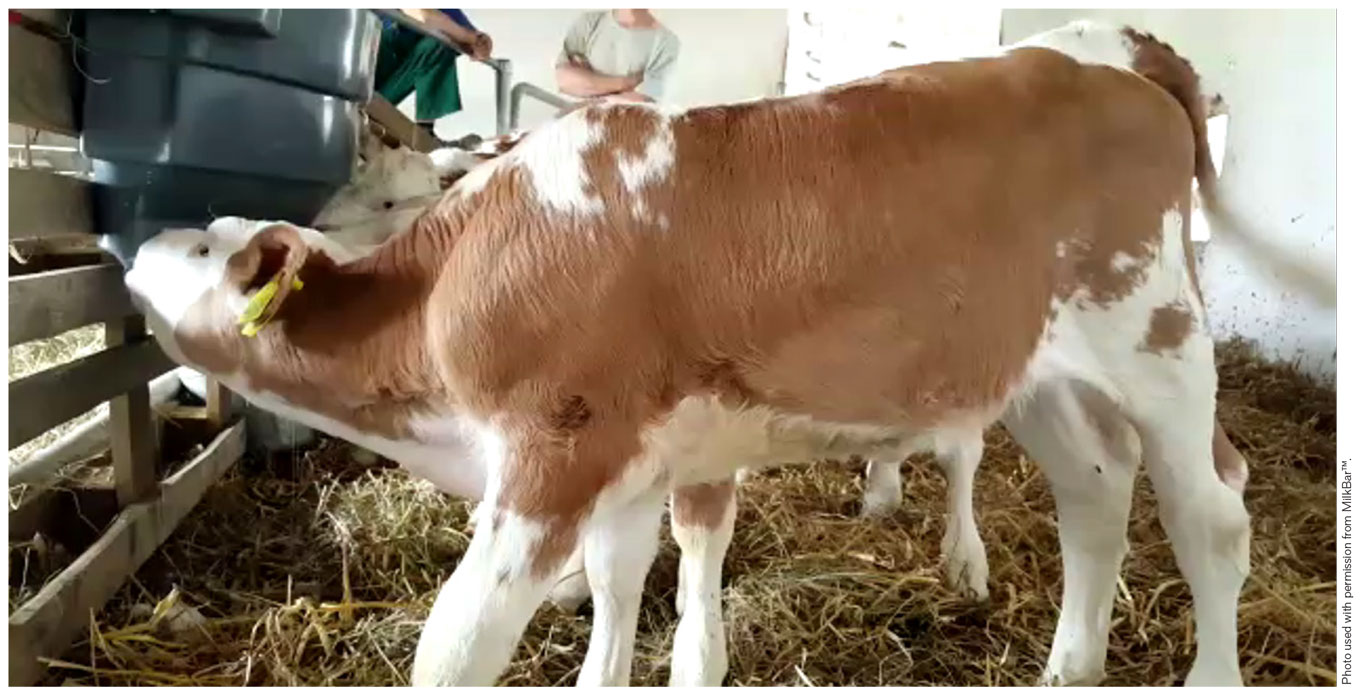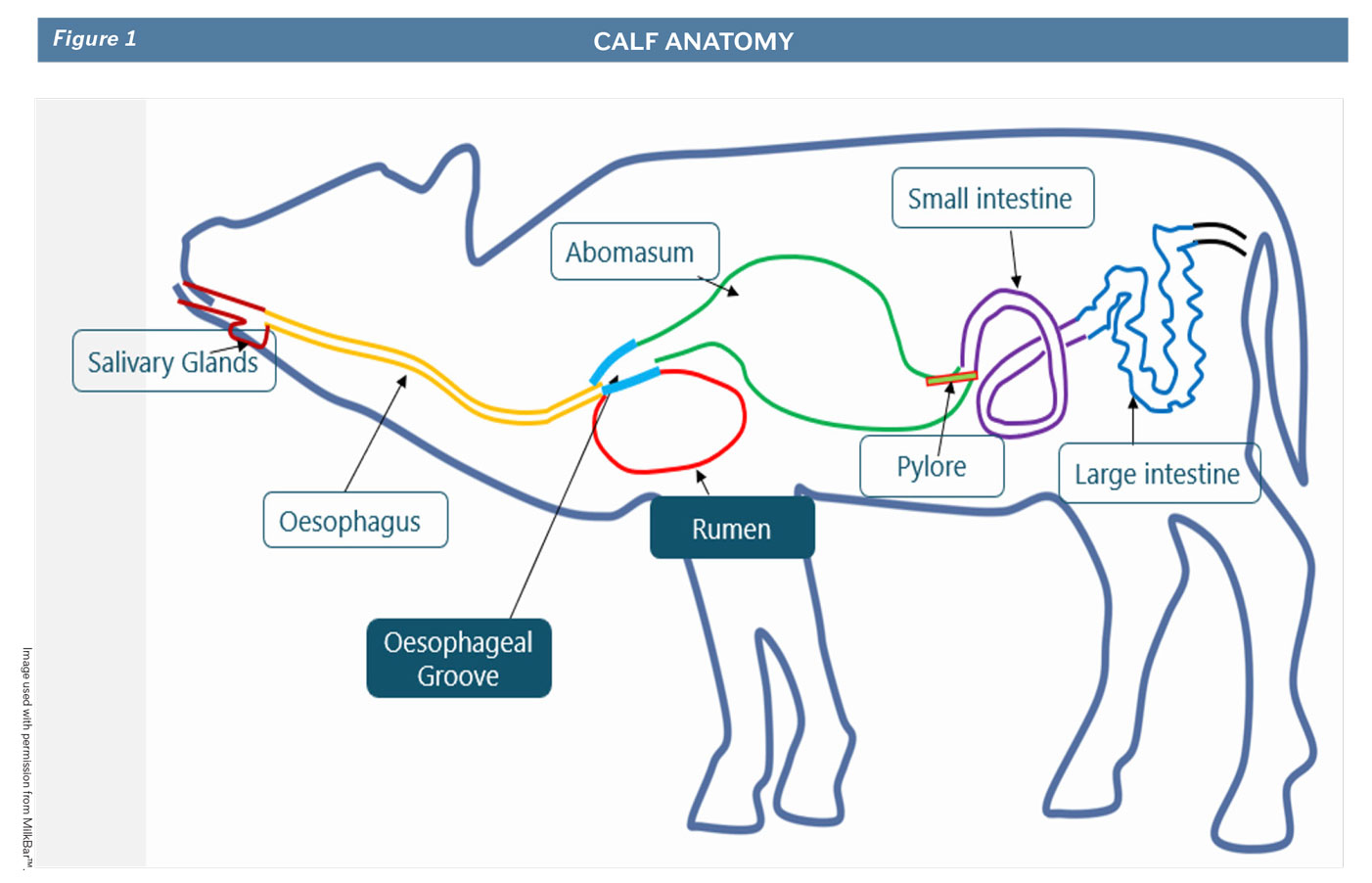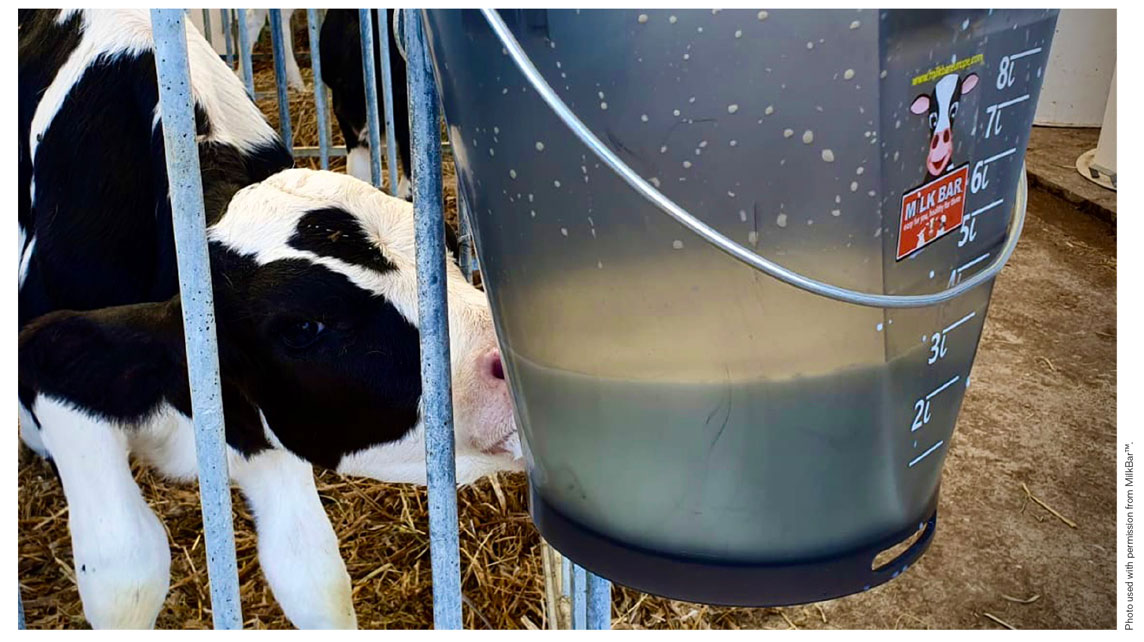Click here to view as a pdf: How To Feed Calves? MilkBar™ Teats Can Improve Calf Gut Health
 By Nele Leiterman, D.V.M.
By Nele Leiterman, D.V.M.
What should I feed my replacement heifers? Whole milk or milk replacer? What fat and crude protein percentage is right for my operation? Are there additives that I should be using? These are typical questions a calf raiser will ask. Often the focus is on WHAT should be fed to the calf, but how often do people think about HOW to feed their calves?
MilkBar™ is a company founded by dairy farmers in New Zealand that looked deep into this HOW. Their innovation is a teat that mimics the natural physiology of how calves nurse from their dams. And the research shows the MilkBar™ controlled-flow teats hold many health benefits for calves and the heifers they will grow into.
This article lists some of the benefits of feeding calves with MilkBar™ teats.
The Physiology of Nursing
When people say calves are “drinking” milk, that is technically not correct. Drinking is the physiological process for the uptake of water. Milk is meant to be nursed from a cow’s udder. While this may seem like a nuance, the distinction between drinking and nursing is quite large from a physiological perspective.
The process of nursing involves the calf’s mouth creating both a positive (pushing down) and negative (sucking) pressure onto the teat. This leads to the calf only being able to achieve and swallow small sips of milk at a time. The calf can essentially nurse at a similar speed that a human can strip out a cow’s teat. If you ever milked a cow by hand, you will have noticed that it takes quite a long time to accumulate one quart with this method. It’s about the same time that a calf needs to nurse one quart from an udder. This is one of the keys to feeding calves. Calves are designed to drink their milk slowly, in a manner that mimics nursing from the dam. 
The position of the calf’s head and neck when nursing is also important. The downward flexed position of the calf’s neck and the proteins in the milk both lead to the reflective contraction of the esophageal groove. The esophageal groove is the body’s version of a bypass valve, and it directs the nursed milk past the first three stomach compartments (rumen, reticulum, and omasum), directly into the abomasum, or what is referred to as the milk stomach. Calves can digest milk only in their abomasum because it contains the necessary digestive enzymes and acids.
When calves drink from a bucket there is a general lack of the physiological response to suckling, so the esophageal groove stays mostly open. Milk gets directed straight into the rumen and from there, overflows into the abomasum (milk stomach). When feeding calves from a bucket 10 – 15% of the milk directly enters the rumen. If the milk accidentally enters the rumen, it will not get digested, but instead, will start to ferment. This can lead to clostridial bloat or other health problems for the calves.
Saliva Production Is Important
While nursing milk from a teat the pressures in the mouth activate the salivary glands of the calf. This is evident by the saliva bubbles that start to form around the calf’s mouth when nursing from a MilkBar™ teat or udder. Time is key when looking at the necessary amount of saliva that needs to be mixed with the portion of milk to digest it. A calf needs 3-4 minutes per quart of milk to produce adequate amounts of saliva. Saliva naturally contains digestive enzymes, antibacterial agents and it buffers the pH of the stomach. Calves create little to no saliva while drinking milk from a bucket. Without sufficient saliva production, none of the essential digestive processes can work properly. This leads to raw milk entering the intestines and studies have found this has an increased risk of diarrhea.

Grow Your Calves to Their Full Potential
Choosing the right feeding system for your farm is not only about the immediate impact on calf health, but also has an impact on the long run for your future dairy cows. Calves that are fed with buckets or fast-feeding teats are often prone to show unnatural behaviours like cross-sucking on other calves in the group. This behavior results from a lack of saliva in their abomasum, which can lead to an upset stomach. Also, because the bucket or fast nursing teat delivered the milk to the calf quickly, there is a lack of neurological feedback to their brains, which is supposed to tell them when they are supposed to be done nursing. This can lead to cross-sucking with group housed calves.
The juvenile udder has natural keratin plugs in the teat canal, that shields the udder tissue from outside pathogens. During cross-sucking, this plug is sucked out, and the developing udder is now unprotected. Bacteria can now enter the udder and colonize the tissue, leading to increased mastitis rates and more heifers with blind quarters.
Often, cross-sucking is addressed by raising calves in individual pens. Calves that do not feel satisfied after drinking from a bucket or fast teat will still suck on objects in their surroundings. Another way to address cross-sucking is to feed calves with a controlled flow nipple like MilkBar™. Think of the effect nursing or a pacifier has on a human infant, the same neurological feedback is also at work in the calf’s brain. Interestingly, cross-sucking is a virtually unknown behavior in beef herds, where calves are always kept together. This illustrates that cross-sucking can be controlled. Feeding calves in a more natural way, with teats that mimics the nursing behavior, seems to be a possible solution. Researchers in France have found that it is possible to keep groups of calves together without cross-sucking if fed with MilkBar™.
There are even more quantitative measurable benefits. One study looked at the daily weight gains of calves fed with different systems. For the trial, calves on one farm were divided into two groups. One group was fed with a controlled-flow teat, the other with a “normal” fast-flowing teat. On all other aspects the calves were treated the same; same volume and type of milk fed, same housing, same offering of water and grain. The calves that were fed with the controlled-flow teats had more than 10% higher average daily weight gains when compared to the other group at weaning.
Conclusion
Plenty of evidence supports that offering calves milk through a controlled-flow MilkBar™ teat has many benefits for calves. Due to the slower drinking speed, the calf produces more saliva, has less milk accidentally reach the rumen, and can better digest the milk. Additionally, negative effects of cross-sucking are negated.
If you want to learn more about calf nutrition and health, feel free to reach out to one of our Crystal Creek® team members at 888-376-6777 or info@crystalcreeknatural.com.
References available upon request.
